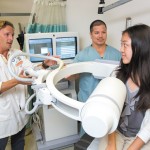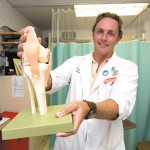Surfing Doctor To The Pros
Dr. Clayton Everline
Sports medicine physician at Straub Hospital
Where did you receive your schooling and training?
I did my undergraduate studies at UC-Berkeley, then I went to Saba University (Caribbean Netherlands) for the didactic portion of medical school with a specialized hyperbaric medicine training program ―I have diving medical officer qualifications. After Saba, I did my clinical rotations in Colorado, then I did my residency training at Seton Hall in New Jersey. I did my sports medicine fellowship at Geisinger in Pennsylvania. There, I was team doctor for the Yankees’ AAA baseball, Penguins AAA hockey, Wilkes arena football teams as well as Wilkes, Misericordia and Bucknell universities and more than 20 area high schools. Then I came out to Hawaii as a volunteer attending physician for the Pipe Masters in 2009, and I’ve been doing so for the past five years.
- Dr. Clay Everline and orthopedic tech Fred DeWitt discuss Justine Wong’s shoulder images taken with a fluoroscopic C-Arm ANTHONY CONSILLIO PHOTOS
- Dr. Everline uses a model knee to discuss injuries from water sports
- Dr. Clayton Everline
I graduated my sports medicine fellowship in 2008.
What made you focus on water sports injuries?
I had been surfing for about 10 years in New Jersey, even before I moved to Hawaii. It was something I obsessed over in my childhood, even though no one in my family surfed. It was something to focus on during residency. It gave me a positive outlook in a world fraught with negativity, and I’ve stuck with it.
You were surfing on the frigid East Coast?
Yes, and it makes me appreciate the waves in Hawaii all the more, and I am motivated to give back to my Hawaii community in exchange for those waves. Thankfully, New Jersey did have some waves, and eastern Pennsylvania, where I did my sports medicine fellowship, wasn’t too far to the beach, just over an hour.
What are some of the most common injuries you see with surfers?
I see a lot of back and neck pain. Oftentimes, the surfer is in spinal hyperextension. The neck is up, craning to see waves or contorted by a vicious, ragdolling wipeout; a lot of shoulder rotator cuff and elbow problems from repetitive paddling and pushing up on the board. Lately, we’re getting a lot of knee and ankle problems, from people trying to do aggressive turning maneuvers, or they get compressed by the wave itself in a funny position. There are a lot of reef cuts, a lot of sprains and strains of muscles about the knee, ankle and shoulder. Occasionally, I see concussions, and more than reef rash, I see urchin wounds and jellyfish stings. No shark bites yet, thankfully. But remember, the biggest teeth in the ocean are the fins on your surfboard.
As a co-author of Surf Survival, can you talk about how the book came to be?
In 2008, I was taking my sports medicine boards and I was trying to remember a mass of information. The way I studied effectively was to apply the information to something I love: surfing. So I took every possible sports injury or condition and extrapolated it to surfing and ended up with a very large monograph. Once I passed my sports medicine boards, I sought out other surfing doctors to see if we could publish something definitively on it. There had been one other book published 20 years before, Sick Surfers by Dr. Mark Renneker, who is the maven of surfing medicine. Getting him involved in our book was really an honor and really helpful in getting all of the data properly presented.
Can you give an example of the research that went into the book?
We included studies that my co-authors and I performed for medical journals, outlining the risk ratios for surfing versus other sports. What we found in 2002, which was published in the American Journal of Emergency Medicine, was that amateur-surfing chest-high waves was safer than soccer, but a little more dangerous than baseball. Surfing Pipeline or a similarly breaking wave that breaks square onto a reef has the oddest risk ratio of injury ― analogous to an hour of playing college football, but the surfers have no padding! (However, some surfers do go out there in helmets, which I recommend to protect not only your dome, but your eardrums from rupturing). It is a significant injury ratio, at six times more chance of having a significant injury in overhead waves breaking on reef.
What are some tips for staying safe in the water, for both amateurs and professionals?
Tier 1: Know what you’re doing. Know what you’re getting yourself into. Know the currents, the tide, the bottom, the crowd. Respect Hawaiian culture and know your kuleana in the water.
Tier 2: Make sure your equipment is safe. That includes using either safety fins or making sure the trailing edges of your fins aren’t overly sharp. Proteck fins and nose guards are available in most shops or online at surfco-hawaii.com.
Tier 3: Make sure you don’t have any chronic injuries that would contribute to putting yourself or others in danger. Make sure your nutrition is sound and that you know your ability to get out of the water, in case something inadvertent happens, including losing or breaking your board, or getting run over.
Do years of surfing help a person be familiar with the surfing environment, or is each beach different?
Like a snowflake, every break is unique. Every break has its moods. I go to a new break hat in hand and try to stay as humble as possible. And respect the locals.
What does being the medical physician at Hawaii’s highest-profile surfing events entail?
Surf events sanctioned by the Association of Surfing Professionals need a doctor on hand at all times. It is similar to being a sideline doctor at a football game, in that you have to be there the entire time, you have to have an emergency action plan and you have to have your own medical supplies that you are responsible for. With the levels of trauma that can escalate, you also have to guarantee access to hospitals and make sure they’re informed of the event going on and what you do as a triage physician.
What kind of injuries do you see at those events?
We have surfers dislocate their shoulders. The wave can be so powerful that just reaching their hand into the wave can result in a dislocated shoulder. Water photographers tend to get their shoulders dislocated because the water constantly brings them over while they’re trying to get the shot. We’ve had head trauma and serious lacerations that need to get washed out and sutured, either on site if it’s guaranteed a clean wound, otherwise they have to be sent to the ER.
Any words of advice for novice surfers?
For beginning surfers, get a book like Surf Survival, because a lot of the content was conceptualized out of studying medicine, seeing these injuries or having them personally, and I don’t want to see anyone hurt unnecessarily. The more knowledge you have going into a situation, the better off you’re going to be.
You’re never going to fully mitigate the risks, but as long as you know your odds, you can make better decisions.






